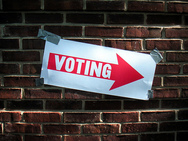Nonpartisan DC primary would give winners more legitimacy

Photo by KCIvey on Flickr.
Since the 2010 general election, DC has had 3 council elections where the winning candidate gained less than 50% of the vote. Our current system too often hands a victory to someone who most voters vote against, in elections that too few voters participate in.
“The way District residents elect a mayor and Council members needs to change,” Chuck Thies noted this week. He’s right. It’s time for a new voting system.
In the 2011 at-large special election, Vincent Orange won with only 29% of the vote. This month, Yvette Alexander won her primary with 42%, and Orange got 40% in the at-large primary.
It diminishes winners’ legitimacy and support for our electoral process to end an election without strong public support for any candidate. And it’s no way to choose our decision makers when we have better options available.
Back in 2010, I argued for scrapping DC’s primary system. DC should replace it, I said, with a single general election with some form of a preferential voting system (like Instant Runoff Voting, Approval Voting, or one of several others).
These other voting systems represent a big change, and stand little chance of becoming law any time soon. But a less radical, yet still effective, option is available.
Nonpartisan blanket primary is the answer
If the District must keep holding primaries, the best model would be to hold a single primary open to all candidates and all voters. The top two vote-getters would then face off again in the general election in November. This system, known as a “nonpartisan blanket primary,” is used in several states including Louisiana and Washington, and was recently adopted in California.
This system would easily work well for electing the mayor, the council chair, the ward councilmembers, and the attorney general (which will be an elected position starting in 2014).
How would at-large seats work?
Electing the at-large seats gets a little more complicated. Currently, 2 at-large seats (not including the chair) are up for election every two years. No party can hold more than 3 of the at-large seats, and because the chair will remain a Democrat for the foreseeable future, only 1 of the 2 at-large seats can go to another Democrat in a given election year.
This creates a complication for a blanket primary, since the top 2 vote-getters in the primary may not both be able to win in the fall if they’re both Democrats. However there is a solution: eliminate these set-asides. The rule isn’t accomplishing anything, anyway: Michael Brown, one of the “independent” members of the council, is in all practical senses a Democrat, and more aligned with his party on a number of issues than some members who are officially Democrats.
This move may also appease a DC Democratic party that might resist opening up the primary. While non-Democrat candidates could be unhappy about losing their set-aside seats, non-Democratic voters, who account for 25% of registered voters, would finally have an opportunity to cast a vote that matters.
Since there are 2 at-large seat open each year, 3 at-large candidates should advance from the primary to the general election. Voters would continue to cast 2 votes for the 2 seats. This would not guarantee that either of the victors would garner 50% of the vote, but it would guarantee that every voter that voted both votes would have chosen at least one winner.
Would the Democratic Party support this?
To implement this new system, the DC Democratic Party will have to get on board. The party has historically resisted any attempts to open the Democratic primary. Typically the argument is that it will lead to “meddling” or mischievous voting by people who aren’t “true Democrats.”
But there is scant evidence that mischievous voting actually occurs in open primaries. In fact, there would be little incentive to vote mischievously because your preferred candidate will need all the votes he or she can get to reach the general election.
Incumbents who have historically been elected and reelected with more than 50% of the vote, which often happens in the ward primaries, would likely continue to win easily under the non-partisan blanket primary system. They’d just have to beat their opponents twice. If they’re popular, this shouldn’t be a problem.
Moreover, with the primaries now so early in the year, an incumbent who loses would be a lame duck for 9 months. How would they govern for so long, knowing they have already been fired? Would they become indifferent? Ineffective? Venal? Voters won’t find out this year, but eventually it will happen. In a nonpartisan blanket primary system, the campaign would continue into the fall, making the lame duck period very short.
Some might argue that the flaws of DC’s voting system are hardly unique, particularly in jurisdictions dominated by one party. That’s true. But it doesn’t make it any more acceptable, especially when a better system is available.
We can continue to use a system where the 60% of the voters, in an election that only 9% of the registered population votes in, vote against a candidate who wins. Or we can demand a better system that produces victors with wider support from a larger electorate. This proposal could deliver that.
